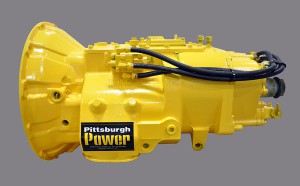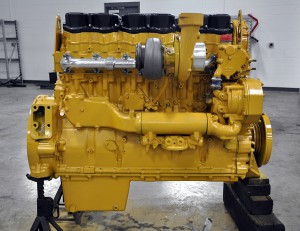 Fall is here and winter is just around the corner – and along with these seasons comes engine rebuilding time. If your engine has less than 1.6 million miles, plan on doing an in-chassis rebuild – it’s much less downtime and more economical. The average in-chassis takes 5 to 7 working days and the average out-of-chassis rebuild is one month. Today’s trucks, especially the aerodynamic ones, require much more work to remove the engine and transmission than on a Peterbilt 379, W-900L Kenworth or a Freightliner Classic, with more time needed to re-install the engine, as well. We only remove the engine if the head gasket surface of the block is worn, the bore in the block for the crank is twisted, or the crankshaft is worn from dirty oil. An out-of-chassis rebuild can take up to three times the labor as an in-chassis rebuild.
Fall is here and winter is just around the corner – and along with these seasons comes engine rebuilding time. If your engine has less than 1.6 million miles, plan on doing an in-chassis rebuild – it’s much less downtime and more economical. The average in-chassis takes 5 to 7 working days and the average out-of-chassis rebuild is one month. Today’s trucks, especially the aerodynamic ones, require much more work to remove the engine and transmission than on a Peterbilt 379, W-900L Kenworth or a Freightliner Classic, with more time needed to re-install the engine, as well. We only remove the engine if the head gasket surface of the block is worn, the bore in the block for the crank is twisted, or the crankshaft is worn from dirty oil. An out-of-chassis rebuild can take up to three times the labor as an in-chassis rebuild.
Caterpillar has done an excellent job of putting together rebuild kits. We normally use the Platinum kit, which consists of rod and main bearings, the oil pan gasket, oil pan isolators, exhaust manifold studs, thermostats, valve cover, fuel and oil filters, cylinder kits, connecting rods, reman head and injectors, and water and oil pump. All of these parts come neatly-packed in a large crate, and then all of the cores go back to Cat in the same crate. When the Pittsburgh Power heavy duty ceramic-coated exhaust manifold, performance turbo, crankshaft damper and balancer, quiet performance mufflers, and 180-degree thermostats are installed, the 475 Cat ends up being a 550 engine that will produce 650 hp. It’s amazing what quality parts that allow the engine to breathe can do to improve an already-great engine!
When doing a rebuild, we always recommend filling the fresh engine with Evans Waterless Coolant, which does not boil until 375 degrees. Another item we recommend is the FASS fuel system, which removes air from the fuel, allows the engine to pull smoother, and adds about 30 more additional hp. Cat says that diesel fuel can be as much as 10% air, which we want to keep out of the injectors. Fuel mileage gains of .2 to .3 mpg are typically seen, as well. Lastly, we suggest that you switch your stock filters to Fleet Air filters. These washable foam filters will stop more dirt and are reusable. You will never have to buy another air filter again, and they will allow the engine to gain .25 mpg. You can even hear the difference in the speed (sound) of the turbo with the Fleet Air filters installed. Of course, we also rebuild Cummins and Detroit engines, too, and all of these same parts apply.
Now, let’s switch gears and talk about transmissions. For those of you who have spoken to me on the phone or at truck shows know, I am not a fan of the 10-speed transmission – my preference is the 13- and 18-speed units. The very first loaded semi I ever drove was from Pittsburgh, PA to Green Bay, WI and the truck was equipped with a 15-speed Eaton Transmission. Years ago I thought that a 15-speed was similar to a 13-speed with two more gears – man, was I wrong! Talk about learning the hard and expensive way.
 After driving that truck, even on the level terrain to Wisconsin, my desire to keep the engine at a given RPM was hampered by the fact that you can’t split a gear with a 15-speed. The 15-speed is a 10-speed with five lower gears (that were never really used in most operations). The RPM of the engine with the 15-speed was either too low or too high when driving in traffic. When there was no traffic and I could determine the speed, the 15-speed was livable.
After driving that truck, even on the level terrain to Wisconsin, my desire to keep the engine at a given RPM was hampered by the fact that you can’t split a gear with a 15-speed. The 15-speed is a 10-speed with five lower gears (that were never really used in most operations). The RPM of the engine with the 15-speed was either too low or too high when driving in traffic. When there was no traffic and I could determine the speed, the 15-speed was livable.
When driving in traffic, on a two-lane road, in a construction zone, in cities, towns or mountains, you have more control of the RPM of the engine when you can split the gears, like with the 13- and 18-speed transmissions. Fleets tell me their drivers are not smart enough to drive a truck equipped with these transmissions, so they stay with the 10-speed in their trucks. I’m shocked at that statement – if their drivers can’t back off the throttle and move the button on the shifter to split a gear, why are they even driving a semi-truck?
Unfortunately, due to the high demand for 13- and 18-speed units, there is a shortage due to the increased amount of glider kits now being sold and built. When trading in your 10-speed for a 13- or 18-speed transmission, you will have to pay a core charge to make the exchange. We currently have both reman and brand new 13- and 18-speed Eaton units available. And, if you’re interested in having a Micro-Blue coated transmission, we will soon have that in stock, as well. The Micro-Blue process, which costs an additional $2,500 or so, usually allows the truck to gain .5 mpg of fuel savings.
The 6NZ Caterpillar is one of the best and most sought-after diesel engines in the world, and the #1 choice of owner operators for glider kits. Well, we just finished building a Signature Series Pittsburgh Power 6NZ Cat and it’s available to you. Horsepower will be adjusted to your specific needs. This engine has been line bored, the block has been resurfaced, the crankshaft has been polished, magnafluxed and straightened, the liner protrusion was set to our specifications so there will not be any head gasket failures, it has all new genuine Cat parts, a ported and ceramic-coated exhaust manifold, a high performance Cat turbo, crankshaft damper, mercury-filled engine balancer, new oil pump and water pump, and custom ECM programming. If there was a better way to build an engine, we would do it! If you are interested in this engine, give us a call at (724) 360-4080. Have a great Holiday Season and start the New Year off right by taking care of the truck that takes care of you all year long – you won’t regret it!

1 Comment
I would like to know your expereince of using Evans Waterless coolant and how it benefits in CAT engines.
many thanks
Mukesh Gupta